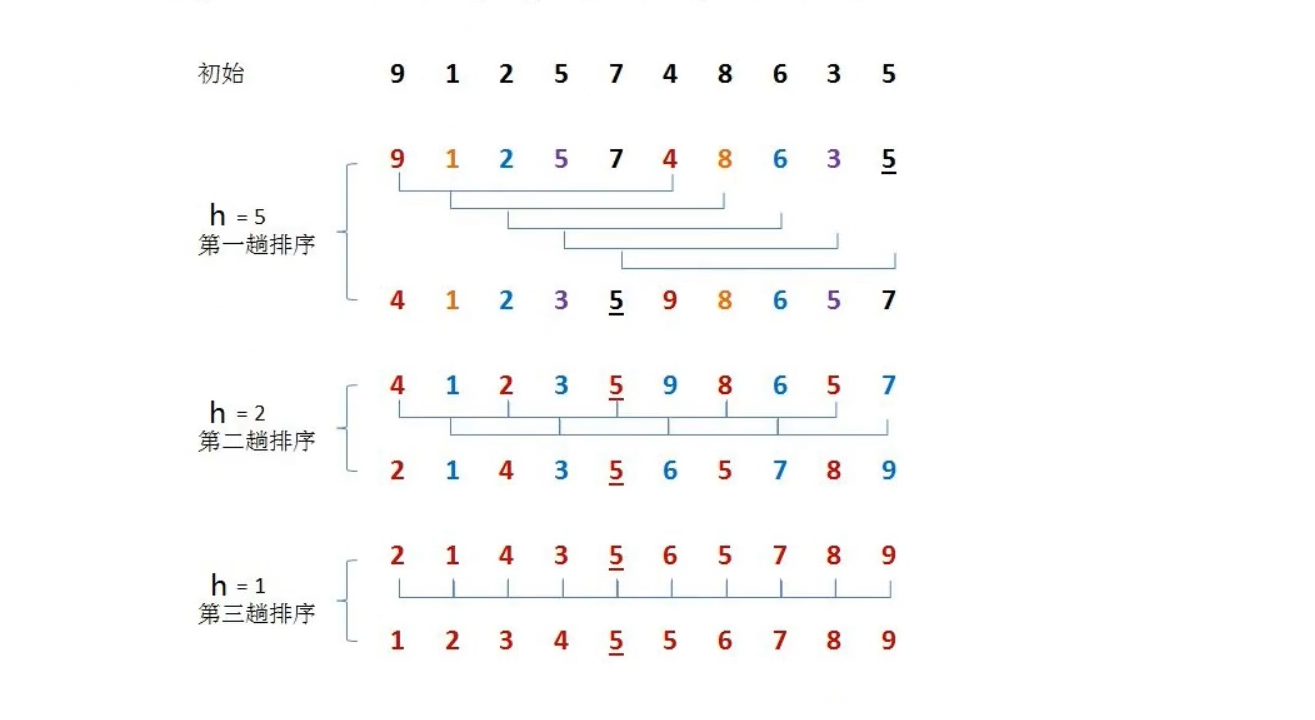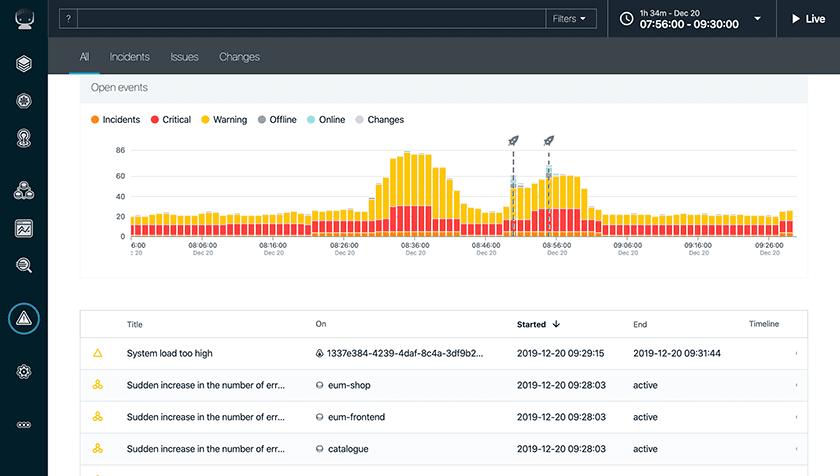希尔排序(Shell's Sort)
简介希尔排序是插入排序的一种,又称“缩小增量排序”,是插入排序算法的一种更高效的改进版本。
希尔排序是插入排序的一种,又称“缩小增量排序”,是插入排序算法的一种更高效的改进版本。
3.4.1、需求
- 排序前:{9, 1, 2, 5, 7, 4, 8, 6, 3, 5}
- 排序后:{1, 2, 3, 4, 5, 5, 6, 7, 8, 9}
3.4.2、排序原理
- 选定一个增长量h,按照增长量h作为数组分组的依据,对数据进行分组
- 对分好组的每一组数据完成插入排序
- 减少增长量,最小减为1,重复第二步操作
增长量h的选取:
int h = 1;//默认为1
while(h<数组的长度/2){
h = 2 * h + 1;
}
#缩小增量,为h/2

3.4.3、API设计
| 类名 | Shell |
|---|---|
| 构造方法 | Shell:创建Shell对象 |
| 成员方法 | public static void sort(Comparable[] a):对数组内的元素进行排序 private static boolean grater(Comparable v,Comparable w):判断v是否大于w private static void exch(Comparable[] a,int i,int j):交换a数组中,索引i和索引j处的值 |
3.4.4、代码实现
算法类:
package cn.test.algorithm.sort;
public class Shell {
/**
* 对数组元素进行排序
*
* @param a
*/
public static void sort(Comparable[] a) {
//根据数组的长度确定增长量h的初始值
int h = 1;
while (h < a.length / 2) {
h = 2 * h + 1;
}
//进行排序
while (h >= 1) {
for (int i = h; i < a.length; i++) {
for (int j = i; j >= h; j -= h) {
if (greater(a[j - h], a[j])) {
exch(a, j - h, j);
} else {
break;
}
}
}
//减小h的
h = h / 2;
}
}
/**
* 比较v元素是否大于w元素
*
* @return
*/
private static boolean greater(Comparable v, Comparable w) {
return v.compareTo(w) > 0;
}
/**
* 交换i和j处的元素值
*
* @param a
* @param i
* @param j
*/
private static void exch(Comparable[] a, int i, int j) {
Comparable temp;
temp = a[i];
a[i] = a[j];
a[j] = temp;
}
}
测试类:
package cn.test.algorithm.test;
import cn.test.algorithm.sort.Shell;
import java.util.Arrays;
public class TestShell {
public static void main(String[] args) {
Integer[] a = {9, 1, 2, 5, 7, 4, 8, 6, 3, 5};
Shell.sort(a);
System.out.println(Arrays.toString(a));
}
}
测试结果:
[1, 2, 3, 4, 5, 5, 6, 7, 8, 9]
3.4.5、时间复杂度分析
由于希尔排序的时间复杂度事前预估法比较难,所以我们采用事后预估法,这里我们通过希尔排序和插入排序进行对比,看看希尔排序的执行时间。
package cn.test.algorithm.test;
import cn.test.algorithm.sort.Insertion;
import cn.test.algorithm.sort.Shell;
public class SortCompare {
public static void main(String[] args) {
//生成10w个证书,数据必须是倒序的,这样才是排序的最坏情况
int num = 100000;
//这里分开写两个数组
Integer[] shellArray = new Integer[num];//希尔排序数组
Integer[] insertionArray = new Integer[num];//插入排序数组
for (int i = num; i > 0; i--) {
shellArray[num - i] = i;
insertionArray[num - i] = i;
}
shellTest(shellArray);
insertionTest(insertionArray);
}
//希尔排序测试
public static void shellTest(Integer[] a) {
long startTime = System.currentTimeMillis();
Shell.sort(a);
long endTime = System.currentTimeMillis();
System.out.println("希尔排序时间:" + (endTime - startTime) + "毫秒");
}
//插入排序测试
public static void insertionTest(Integer[] a) {
long startTime = System.currentTimeMillis();
Insertion.sort(a);
long endTime = System.currentTimeMillis();
System.out.println("插入排序时间:" + (endTime - startTime) + "毫秒");
}
}
运行结果:
希尔排序时间:24毫秒
插入排序时间:20380毫秒
从结果可以看出,希尔排序的效率是非常高的。
 快速生成表格
快速生成表格 无向图(Undirected Graph)
无向图(Undirected Graph) Python调用WPS把文档转换PDF,并把PDF转图片,首先需要安装WPS,然后利用pypiwin32把文档转化成PDF,再利用fitz、PyMuPD把PDF转化成图片
Python调用WPS把文档转换PDF,并把PDF转图片,首先需要安装WPS,然后利用pypiwin32把文档转化成PDF,再利用fitz、PyMuPD把PDF转化成图片 “冰墩墩(英文:Bing Dwen Dwen,汉语拼音:bīng dūn dūn),是2022年北京冬季奥运会的吉祥物。将熊猫形象与富有超能量的冰晶外壳相结合,头部外壳造型取自冰雪运动头盔,装饰彩色光环,整体形象酷似航天员。那么本文就用python写一个冰墩墩。
“冰墩墩(英文:Bing Dwen Dwen,汉语拼音:bīng dūn dūn),是2022年北京冬季奥运会的吉祥物。将熊猫形象与富有超能量的冰晶外壳相结合,头部外壳造型取自冰雪运动头盔,装饰彩色光环,整体形象酷似航天员。那么本文就用python写一个冰墩墩。 APM(Application Performance Management)即应用性能管理系统,是对企业系统及时监控以实现对应用程序性能管理和故障管理的系统化解决方案。应用性能管理,主要指对企业的关键业务应用进行监控、优化,提高企业的应用的可靠性和治理,保证用户得到良好的服务,减低IT总拥有成本。
APM(Application Performance Management)即应用性能管理系统,是对企业系统及时监控以实现对应用程序性能管理和故障管理的系统化解决方案。应用性能管理,主要指对企业的关键业务应用进行监控、优化,提高企业的应用的可靠性和治理,保证用户得到良好的服务,减低IT总拥有成本。 Electron页面跳转、浏览器打开链接和打开新窗口
Electron页面跳转、浏览器打开链接和打开新窗口 在使用Git的过程中,不想每次都输入用户名和密码去拉取代码,所以就需要保存这些信息,那么既然有保存了,就必须有清除功能。
在使用Git的过程中,不想每次都输入用户名和密码去拉取代码,所以就需要保存这些信息,那么既然有保存了,就必须有清除功能。 Docker编译镜像出现:fetch http://dl-cdn.alpinelinux.org/alpine/v3.12/main/x86_64/APKINDEX.tar.gz
ERROR: http://dl-cdn.alpinelinux.org/alpine/v3.12/main: temporary error (try again later)
WARNING: Ignoring APKINDEX.2c4ac24e.tar.gz: No such file or directory问题
Docker编译镜像出现:fetch http://dl-cdn.alpinelinux.org/alpine/v3.12/main/x86_64/APKINDEX.tar.gz
ERROR: http://dl-cdn.alpinelinux.org/alpine/v3.12/main: temporary error (try again later)
WARNING: Ignoring APKINDEX.2c4ac24e.tar.gz: No such file or directory问题 在Mac电脑中,如何对Git的用户名和密码进行修改呢?起初不懂Mac,所以整了很久,本文将记录如何对这个进行操作,以便后期使用。
在Mac电脑中,如何对Git的用户名和密码进行修改呢?起初不懂Mac,所以整了很久,本文将记录如何对这个进行操作,以便后期使用。